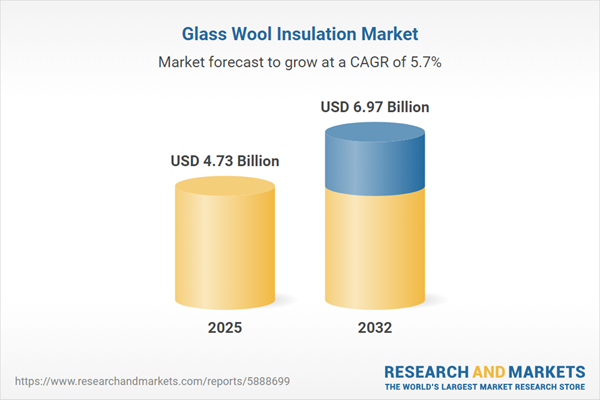Speak directly to the analyst to clarify any post sales queries you may have.
For organizations focused on operational resilience and sustainability, the glass wool insulation market stands as a proven solution for regulatory compliance, risk management, and delivering consistent performance across diverse projects.
Market Snapshot: Glass Wool Insulation Market Size and Growth
The glass wool insulation market is advancing steadily, supported by stricter energy efficiency regulations and the ongoing adoption of sustainable construction practices. In 2024, the market is valued at USD 4.47 billion, projected to grow to USD 4.73 billion by 2025 and reach USD 6.97 billion by 2032—representing a compound annual growth rate (CAGR) of 5.70%. Market expansion reflects increased alignment with evolving building codes, enhanced supply chain strategies, and a heightened focus on circularity. Organizations are refining approaches to regional regulations and operational efficiency to ensure durable competitive advantages within this dynamic sector.
Scope & Segmentation of the Glass Wool Insulation Market
This executive briefing brings clarity to procurement, capital investment, and long-range planning decisions. The following market segments, technologies, and regional dynamics shape modern strategies for manufacturers and large-scale buyers:
- Applications: Supports commercial, industrial, and residential needs in both new constructions and upgrades, advancing energy management and sustainability leadership.
- Product Forms: Includes board, loose fill, pipe section, and roll for flexibility in installation methods and project requirements.
- End Use: Addresses insulation for ceilings, ductwork, floors, roofs, and walls, optimizing efficiency while improving occupant comfort.
- Thermal Conductivity Ranges: Offers multiple grades, enabling compliance with stringent codes and adaptation to local climate standards.
- Fiber Types: Incorporates standard and recycled fibers, supporting sustainability goals and steady material supply.
- Density Grades: Facilitates enhanced acoustic control and sound absorption for demanding settings such as high-traffic zones and noise-sensitive environments.
- Binder Types: Provides a range from formaldehyde-based and formaldehyde-free to bio-based and polyester binders, helping organizations meet green certification and air quality objectives.
- Installation Channels: Distributes through contractor networks and DIY retailers, offering flexibility for timely implementation in small-scale and large-scale projects alike.
- Regions: Covers the Americas, Europe, the Middle East and Africa, and Asia-Pacific, each influencing technology adoption and compliance strategies based on distinct regulatory frameworks and environmental drivers.
- Major Companies: Industry innovators such as Owens Corning, Knauf Insulation GmbH, Compagnie de Saint-Gobain SA, Johns Manville Corporation, and URSA Insulation S.A. steer sector advancements, product expansion, and partnership opportunities.
Key Takeaways for Decision-Makers
- Proactive adaptation of product ranges enables firms to efficiently address complex building codes and changing regulatory expectations.
- Adoption of advanced binder technologies and greater reliance on recycled fibers enhance compliance with sustainability standards and promote responsible sourcing models.
- Integration of digital platforms, such as real-time analytics and adaptive supply chain tools, strengthens procurement speed and mitigates risks from market disruptions.
- Region-specific product preferences underscore the importance of localized strategies; for example, board insulation predominates in North America while roll formats are prevalent in Asia-Pacific.
- Strengthening supplier networks and building enduring relationships help safeguard business continuity amid fluctuating regulations and shifts in global supply.
- Expanding local manufacturing presence supports operational stability, ensuring consistent delivery and reducing vulnerability to external volatility.
Tariff Impact: Navigating the US Trade Landscape
US tariffs on insulation materials are prompting organizations to shift toward domestic sourcing and adapt supply networks. These strategic changes are essential for sustaining operational performance and reinforcing supply chain reliability in a volatile global trade context.
Methodology & Data Sources
This report is based on structured interviews with industry leadership, technical and regulatory document analysis, and cross-checked against authoritative market data sources. All insights are validated by industry subject matter experts to guarantee executive-level relevance for glass wool insulation market stakeholders.
Why This Report Matters
- Equips procurement and facility leaders with actionable intelligence for tailoring sourcing and investment policies to evolving compliance and regional needs.
- Supports strategy development by illustrating effective product innovation, regulatory adaptation, and operational best practices across key global regions.
- Enables executives to maximize returns, establish resilient supply networks, and incorporate emerging technologies in insulation projects.
Conclusion
This executive overview delivers essential, validated intelligence to senior decision-makers, enabling sound investments and position management within a rapidly transforming glass wool insulation landscape.
Additional Product Information:
- Purchase of this report includes 1 year online access with quarterly updates.
- This report can be updated on request. Please contact our Customer Experience team using the Ask a Question widget on our website.
Table of Contents
3. Executive Summary
4. Market Overview
7. Cumulative Impact of Artificial Intelligence 2025
Companies Mentioned
The companies profiled in this Glass Wool Insulation market report include:- Owens Corning
- Knauf Insulation GmbH
- Compagnie de Saint-Gobain SA
- Johns Manville Corporation
- URSA Insulation S.A.
Table Information
| Report Attribute | Details |
|---|---|
| No. of Pages | 195 |
| Published | October 2025 |
| Forecast Period | 2025 - 2032 |
| Estimated Market Value ( USD | $ 4.73 Billion |
| Forecasted Market Value ( USD | $ 6.97 Billion |
| Compound Annual Growth Rate | 5.7% |
| Regions Covered | Global |
| No. of Companies Mentioned | 6 |









